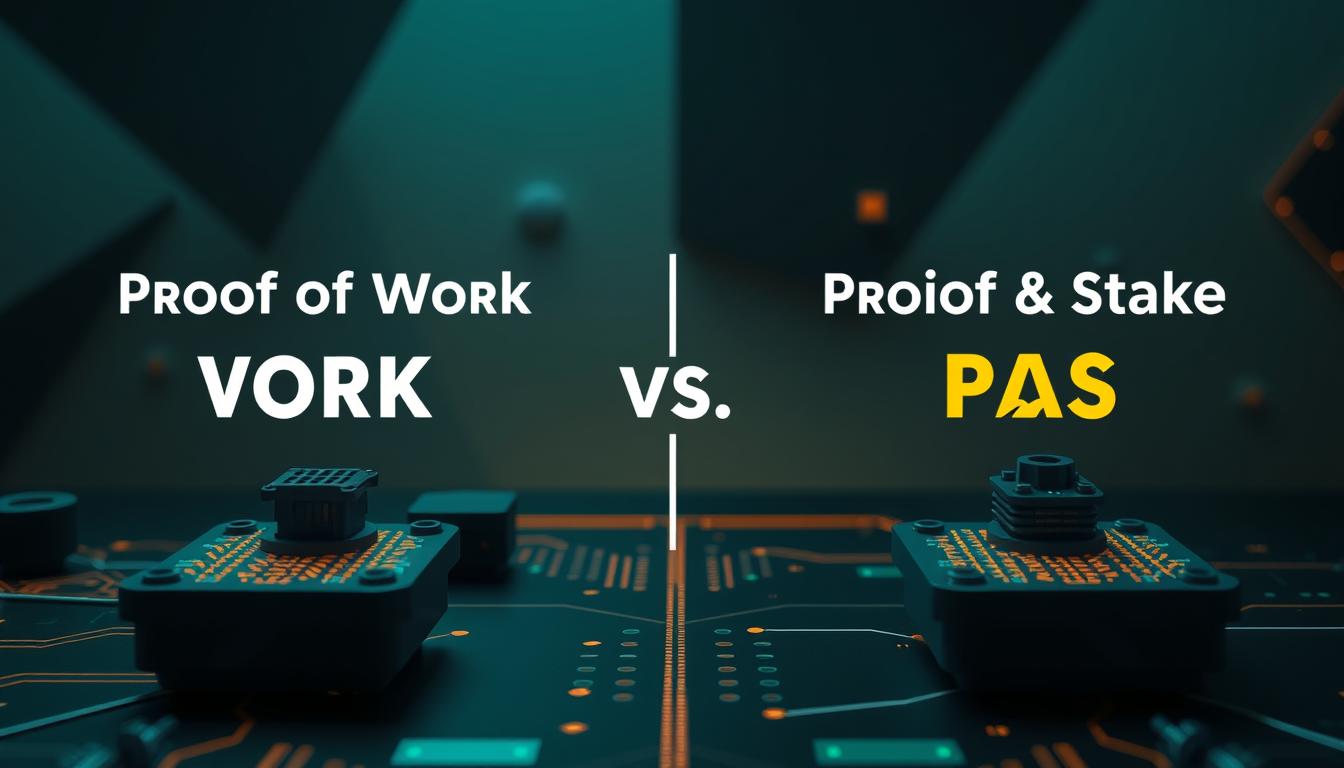Now Reading: Detailed Comparison: Proof of Work vs Proof of Stake Explained
- 01
Detailed Comparison: Proof of Work vs Proof of Stake Explained
Detailed Comparison: Proof of Work vs Proof of Stake Explained

At the heart of every major cryptocurrency lies a consensus mechanism. This is the core rule set that allows a decentralized blockchain network to agree on a single truth without a central authority. It ensures security and validates every transaction.
Proof of Work (PoW) was the first successful mechanism. It secures the network by requiring miners to solve complex math puzzles using computational power. This process, or “work,” validates transactions and creates new blocks.
As an alternative, Proof of Stake (PoS) emerged. Instead of computational power, it uses coin ownership. Validators are chosen to create new blocks based on the amount of cryptocurrency they “stake,” or lock up, as collateral.
The debate between these two foundational models is central to the evolution of blockchain technology. It touches on critical issues like energy use, security, and how well a network can scale. Understanding the differences between PoW and PoS is key to grasping the future of digital assets.
Key Takeaways
- Consensus mechanisms are the rules that allow decentralized networks to agree on transaction history.
- Proof of Work (PoW) relies on competitive computational problem-solving to secure the blockchain.
- Proof of Stake (PoS) selects validators based on the amount of cryptocurrency they hold and stake.
- The primary difference lies in the resource used: energy for PoW versus financial stake for PoS.
- This comparison explores the trade-offs in security, energy consumption, and scalability.
Introduction to Cryptocurrency Consensus Mechanisms
For a digital currency to be truly trustless, it must solve a critical problem: how to agree on a single truth. This is the primary challenge that consensus mechanisms are designed to overcome in a decentralized blockchain network.
Understanding Blockchain and Decentralization
A blockchain is a ledger spread across thousands of independent computers, called nodes. Unlike a bank, there is no central authority in charge. This decentralization is a key strength, but it creates a coordination challenge.
How can all these separate participants agree on which transactions are valid? They need a set of rules everyone follows. This set of rules is the consensus mechanism.
The Role of Consensus in Secure Transactions
The most famous problem a consensus mechanism prevents is double-spending. This is the risk of someone spending the same digital coin twice. Centralized systems, like a credit card company, solve this easily. They have a central database that checks every payment.
In a decentralized network, the mechanism acts as the referee. It ensures all participants independently reach the same conclusion about the order and validity of transactions. This creates trust through code and economics, not a central institution.
| Feature | Centralized System (e.g., Bank) | Decentralized Blockchain |
|---|---|---|
| Control | Single authority | Distributed network of nodes |
| Trust Source | Institutional reputation | Cryptographic rules & economic incentives |
| Transaction Validation | Central server approves | Consensus mechanism decides |
| Primary Challenge | Single point of failure | Reaching agreement without a leader |
Overview of Proof of Work (PoW)
The pioneering consensus model that launched the cryptocurrency revolution relies on competitive computation. This system requires network participants to solve complex mathematical puzzles using significant computing resources.
Mining, Hashing, and Energy Demands
Mining forms the core of the PoW process. Miners use specialized hardware to perform trillions of calculations per second. Their goal is to find a specific number that produces a valid hash.
The hashing process involves testing different values until one meets the network’s difficulty target. This requires enormous computational power. The system automatically adjusts difficulty to maintain consistent block creation times.
Successful miners earn newly created cryptocurrency plus transaction fees. This economic incentive drives participation despite high costs. The security comes from the massive energy investment required to attack the network.
Bitcoin remains the most prominent PoW network. Others include Litecoin and Monero. The electricity consumption of these networks exceeds that of small countries, raising environmental concerns.
Overview of Proof of Stake (PoS)
The Proof of Stake model transforms blockchain participation from hardware investment to economic stake, creating a more accessible and efficient system. This approach selects network validators based on their financial commitment rather than computational power.

Staking, Validators, and Reduced Energy Needs
To become a validator, participants must lock up a specific amount of cryptocurrency. For example, Ethereum requires 32 ETH to operate a validator node. This staked amount serves as collateral for honest behavior.
The network uses random selection weighted by stake size to choose who proposes the next block. Validators earn rewards for correct actions but face penalties called slashing for misconduct. This creates strong financial incentives for proper validation.
Multiple validators must confirm each block’s accuracy before finalization. This distributed verification process enhances security while maintaining efficiency. The system eliminates energy-intensive mining computations.
Major networks using this mechanism include Ethereum, Cardano, and Solana. Users can participate through staking pools without meeting full validator requirements. Liquid staking options allow delegation while maintaining fund control.
proof of work vs proof of stake detailed comparison
Blockchain architects face a critical design choice between computational power and economic commitment for network security. Each approach offers distinct advantages that suit different priorities and use cases.
Direct Side-by-Side Analysis of Mechanisms
The pow model secures networks through energy-intensive calculations. Miners compete to solve complex puzzles using specialized hardware. This process validates transactions and creates new blocks.
In contrast, pos relies on financial stake rather than computational work. Validators are chosen based on the amount of cryptocurrency they lock up as collateral. This approach uses minimal energy compared to traditional mining.

Security models differ significantly between the two consensus approaches. Pow requires attackers to control majority computing power. Pos demands control of most staked coins while risking financial penalties.
Transaction processing capabilities also vary. Pow networks like Bitcoin handle approximately 7 transactions per second. Pos systems enable faster block times and higher throughput, as explained in this comparative analysis.
| Feature | Proof of Work | Proof of Stake |
|---|---|---|
| Primary Resource | Computational power & energy | Financial stake & collateral |
| Energy Consumption | Very high | Minimal |
| Transaction Speed | Slower (Bitcoin: ~7 TPS) | Faster (higher throughput) |
| Hardware Requirements | Specialized mining equipment | Standard internet-connected device |
| Network Maturity | Proven since 2009 (Bitcoin) | Newer, still evolving |
Accessibility differs between models. Pow mining has become concentrated in large operations due to high costs. Pos participation requires significant capital for meaningful stake, though pooled staking options increase accessibility.
Energy Consumption and Environmental Impact
Energy efficiency separates the two leading consensus mechanisms by orders of magnitude. This difference has become a central issue in blockchain adoption debates worldwide.
High Energy Costs of PoW Mining
Bitcoin’s mining operations consume more electricity than entire countries like Belgium. Each transaction generates hundreds of kilograms of CO₂ emissions.
The competitive mining process creates an arms race for computational power. Miners constantly upgrade specialized hardware, generating substantial electronic waste.
Energy Efficiency Benefits of PoS
Ethereum’s transition to this model reduced its energy consumption by 99.84%. Validators operate on standard devices instead of power-hungry equipment.
The system eliminates computational competition, the primary driver of high energy costs. This approach maintains security while dramatically reducing environmental impact.

| Aspect | Proof of Work | Proof of Stake |
|---|---|---|
| Energy Usage | Extremely high (country-level) | Minimal (standard device) |
| Carbon Footprint | Significant CO₂ emissions | Negligible emissions |
| Hardware Impact | Specialized mining equipment | Regular internet devices |
| Electronic Waste | Substantial from upgrades | Minimal generation |
While PoW’s energy use provides security, PoS achieves similar protection with far lower environmental impact. This efficiency advantage is reshaping blockchain development priorities.
Security, Scalability, and Transaction Processes
How a blockchain protects against attacks and handles high transaction volumes reveals the practical strengths of its underlying consensus model. These operational characteristics determine real-world viability.

Robust Security Through Computational Work vs. Economic Incentives
Proof of Work secures the network by making attacks economically unfeasible. Changing transaction history requires redoing all computational work, which becomes prohibitively expensive over time.
In contrast, Proof of Stake uses economic penalties to maintain security. Validators who attempt dishonest activity face slashing of their staked cryptocurrency. This creates strong financial incentives for proper behavior.
Scalability and Transaction Speed Considerations
Proof of Work faces inherent scalability limitations. Bitcoin’s hardware constraints limit it to approximately 7 transactions per second.
Proof of Stake systems enable higher throughput and faster block times. They can adjust based on network activity, making them suitable for high-demand applications.
Impact on Network Congestion and Validator Incentives
Transaction finality differs significantly between models. Proof of Work relies on probabilistic finality requiring multiple confirmations.
Proof of Stake achieves faster deterministic finality using advanced algorithms. This reduces the window for transaction reversals while maintaining security.
Validator rewards also differ. Miners earn block rewards plus fees, while validators receive transaction fees through the staking process.
Future Trends and Innovations in Consensus Mechanisms
As blockchain adoption grows, developers are exploring creative alternatives to traditional validation methods. The search for optimal consensus mechanisms continues beyond the established approaches.
New hybrid models combine different validation techniques. These systems aim to leverage the strengths of multiple approaches.
Hybrid Models and Emerging Consensus Strategies
Projects like Decred demonstrate innovative thinking. They blend mining with staking elements for balanced governance.
Other emerging mechanisms take fundamentally different paths. Proof of Authority uses identity-based validation for enterprise applications.
Delegated Proof of Stake allows token holders to vote for validators. This increases throughput but concentrates power among fewer participants.
Industry Shifts and Regulatory Considerations
Regulatory attention has increased significantly. Lawmakers focus on energy consumption concerns.
Several proposals address sustainability standards for mining operations. This pressure influences blockchain design decisions.
The trend points toward continued experimentation. Future networks may use specialized consensus approaches for different use cases.
Conclusion
The journey through consensus mechanisms reveals no single perfect solution. Each approach serves distinct purposes based on a network’s core objectives.
Proof of Work provides time-tested security through massive computational investment. This makes it ideal for networks prioritizing absolute immutability over speed.
Proof of Stake offers dramatically reduced energy consumption and greater scalability. This supports complex applications and higher transaction volumes. Many users now participate through Ethereum staking services.
The choice represents fundamental trade-offs between security, efficiency, and decentralization. Different blockchain systems weight these factors according to their specific goals.
Understanding these mechanisms empowers better evaluation of cryptocurrency projects. As technology evolves, both approaches continue to refine their unique strengths.
FAQ
Which cryptocurrency uses Proof of Work?
Bitcoin is the most prominent cryptocurrency that uses the Proof of Work mechanism. Other notable examples include Litecoin, Bitcoin Cash, and, until its Merge upgrade in 2022, Ethereum. These networks rely on miners using powerful hardware to validate transactions and secure the blockchain.
Is Proof of Stake more secure than Proof of Work?
Both systems provide security, but through different means. Proof of Work security comes from the immense computational power required to attack the network. Proof of Stake security is based on economic incentives; an attacker would need to own a majority of the staked coins, making an attack extremely costly. Each has unique strengths and potential vulnerabilities.
What is the main advantage of Proof of Stake for a blockchain network?
The primary advantage is dramatically reduced energy consumption. By eliminating the need for competitive mining with powerful hardware, Proof of Stake systems like Ethereum 2.0 and Cardano use over 99% less electricity. This also lowers the barrier to entry for participants, as staking does not require expensive equipment.
Can you lose your staked coins in a Proof of Stake system?
Yes, this is known as “slashing.” If a validator in a Proof of Stake network acts maliciously or fails to perform their duties correctly (like being offline too often), the system can penalize them by taking a portion of their staked coins. This mechanism incentivizes good behavior and helps maintain network integrity.
How does transaction speed compare between PoW and PoS blockchains?
Proof of Stake networks generally offer faster transaction speeds and greater scalability. Without the intensive mining process, blocks can be created and validated more quickly. This helps reduce network congestion and lower transaction fees, making PoS blockchains like Solana and Avalanche capable of handling significantly more activity per second than traditional PoW chains.
What are the hardware requirements for participating in each consensus mechanism?
Proof of Work requires specialized, energy-intensive mining rigs like ASICs (Application-Specific Integrated Circuits) to be competitive. In contrast, Proof of Stake participation as a validator often requires a standard computer server and a specific amount of the native cryptocurrency to stake, making it more accessible and less costly in terms of hardware and electricity.













